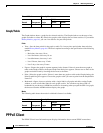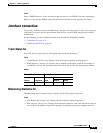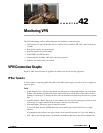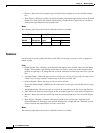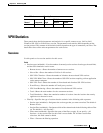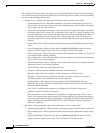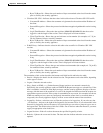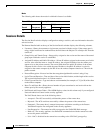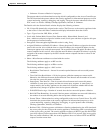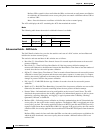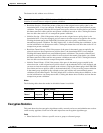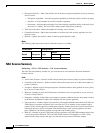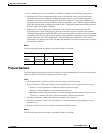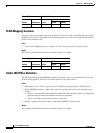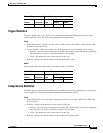
42-6
Cisco ASDM User Guide
OL-16647-01
Chapter 42 Monitoring VPN
VPN Statistics
Modes
The following table shows the modes in which this feature is available:
Sessions Details
The Session Details window displays configuration settings, statistics, and state information about the
selected session.
The Remote Detailed table at the top of the Session Details window displays the following columns:
• Username—Shows the username or login name associated with the session. If the remote peer is
using a digital certificate for authentication, the field shows the Subject CN or Subject OU from the
certificate.
• Group Policy and Tunnel Group—Group policy assigned to the session and the name of the tunnel
group upon which the session is established.
• Assigned IP Address and Public IP Address—Private IP address assigned to the remote peer for this
session. Also called the inner or virtual IP address, the assigned IP address lets the remote peer
appear to be on the private network. The second field shows the public IP address of the remote
computer for this session. Also called the outer IP address, the public IP address is typically
assigned to the remote computer by the ISP. It lets the remote computer function as a host on the
public network.
• Protocol/Encryption—Protocol and the data encryption algorithm this session is using, if any.
• Login Time and Duration—Time and date of the session initialization, and the length of the session.
The session initialization time is in 24-hour notation.
• Client Type and Version—Type and software version number (for example, rel. 7.0_int 50) of the client
on the remote computer.
• Bytes Tx and Bytes Rx—Shows the total number of bytes transmitted to and received from the
remote peer by the security appliance.
• NAC Result and Posture Token—The ASDM displays values in this column only if you configured
Network Admission Control on the security appliance.
The NAC Result shows one of the following values:
–
Accepted—The ACS successfully validated the posture of the remote host.
–
Rejected—The ACS could not successfully validate the posture of the remote host.
–
Exempted—The remote host is exempt from posture validation according to the Posture
Validation Exception list configured on the security appliance.
–
Non-Responsive—The remote host did not respond to the EAPoUDP Hello message.
–
Hold-off—The security appliance lost EAPoUDP communication with the remote host after
successful posture validation.
–
N/A—NAC is disabled for the remote host according to the VPN NAC group policy.
Firewall Mode Security Context
Routed Transparent Single
Multiple
Context System
• — • ——



